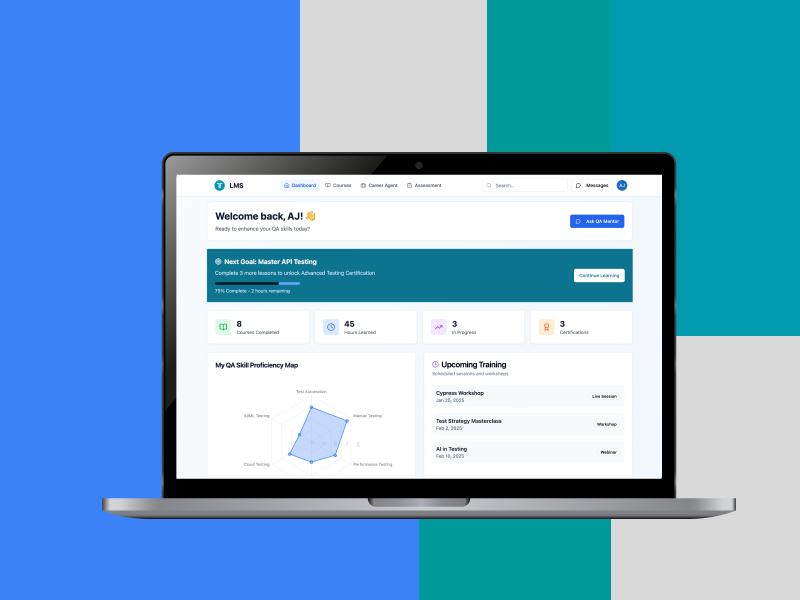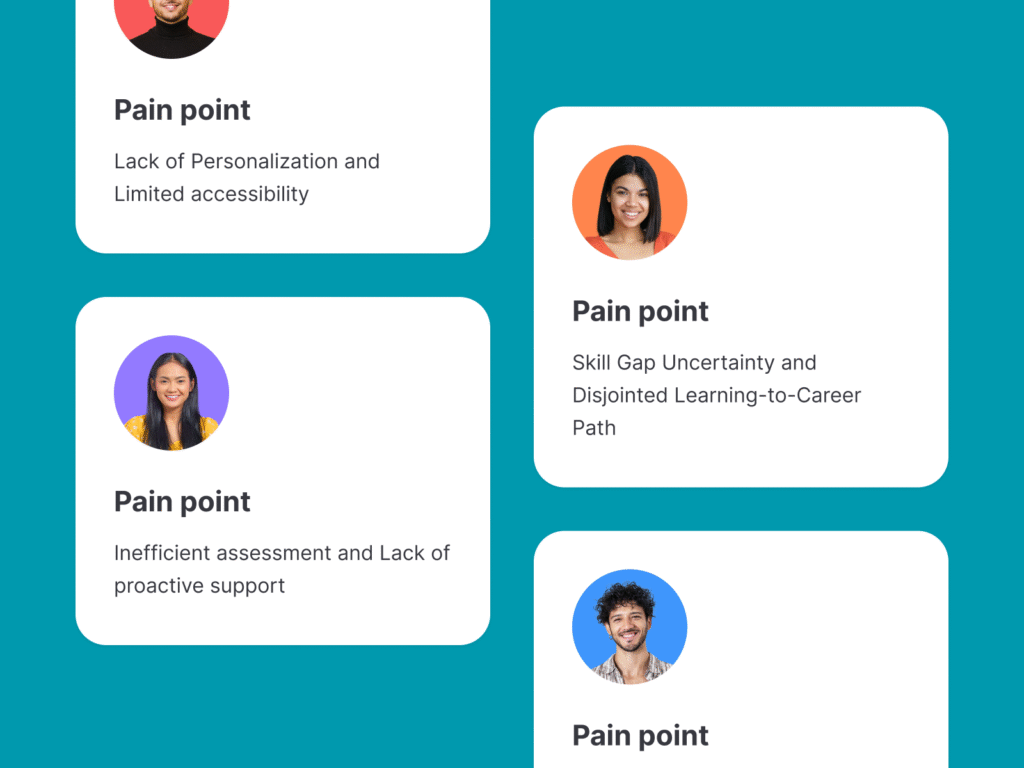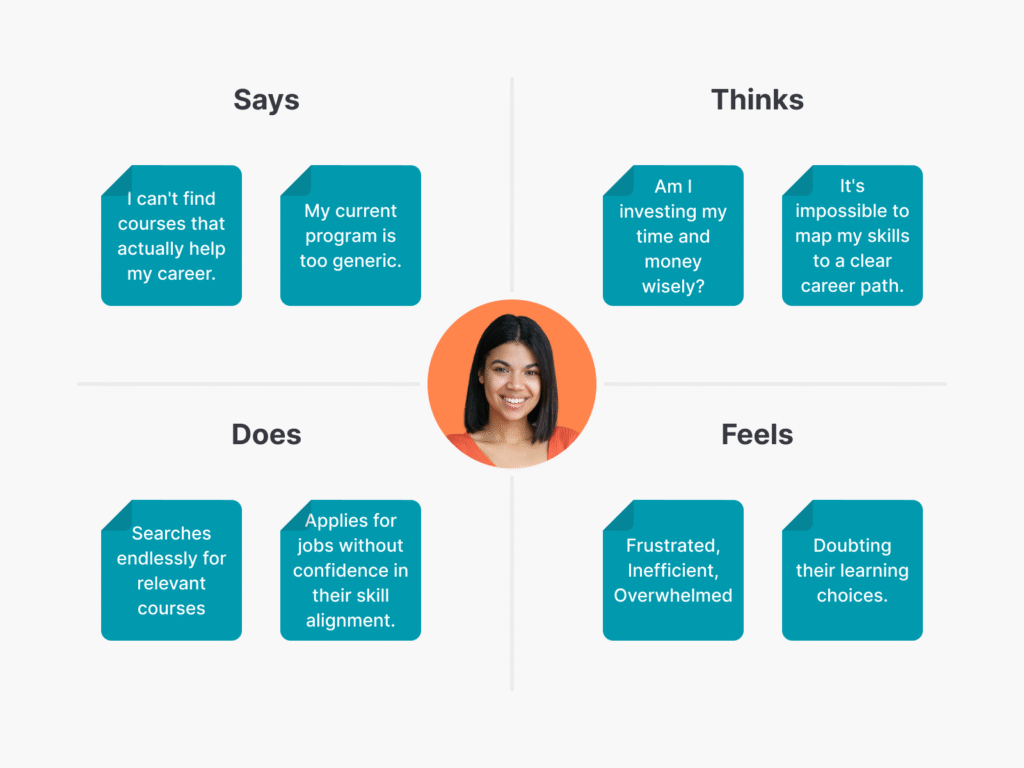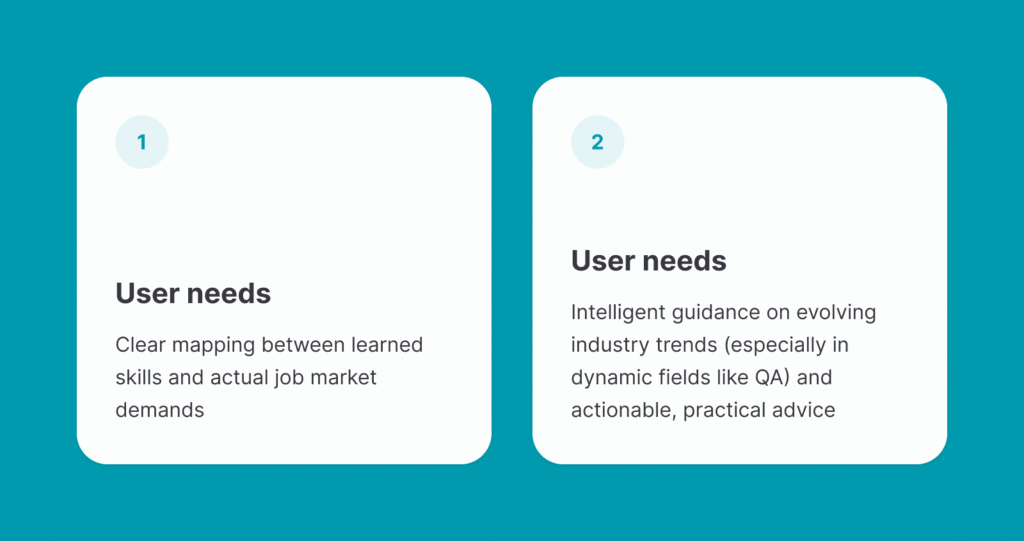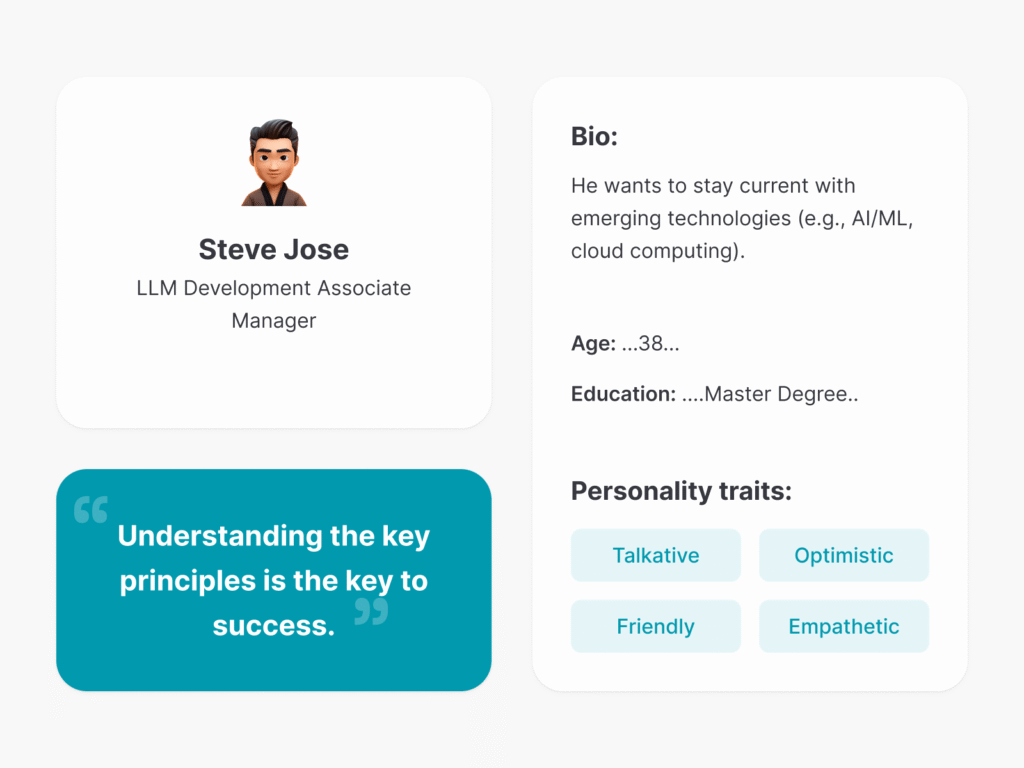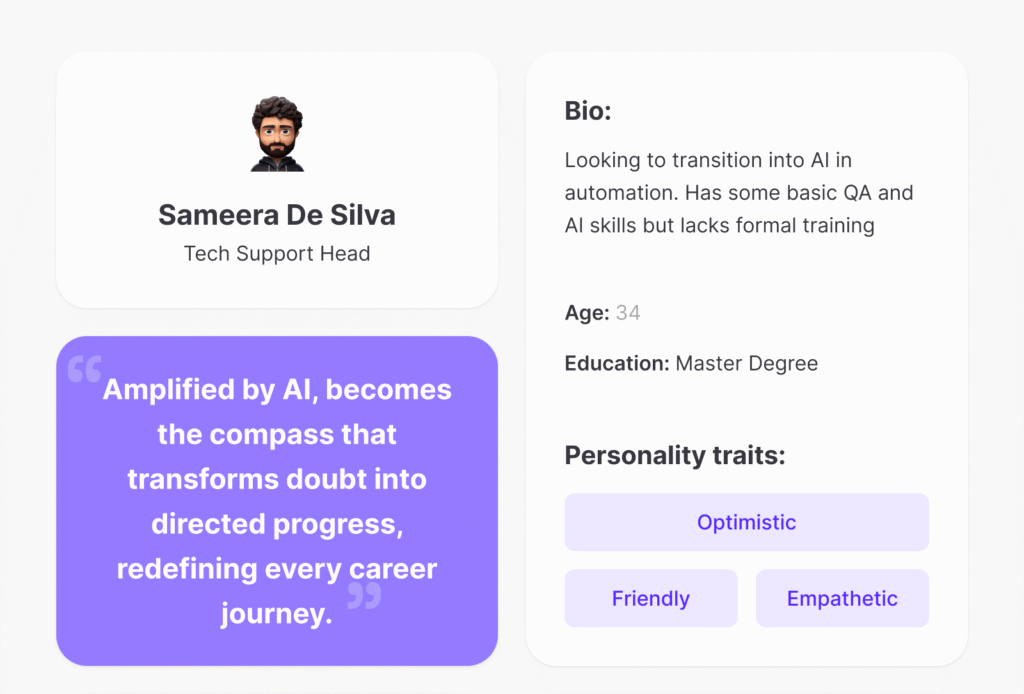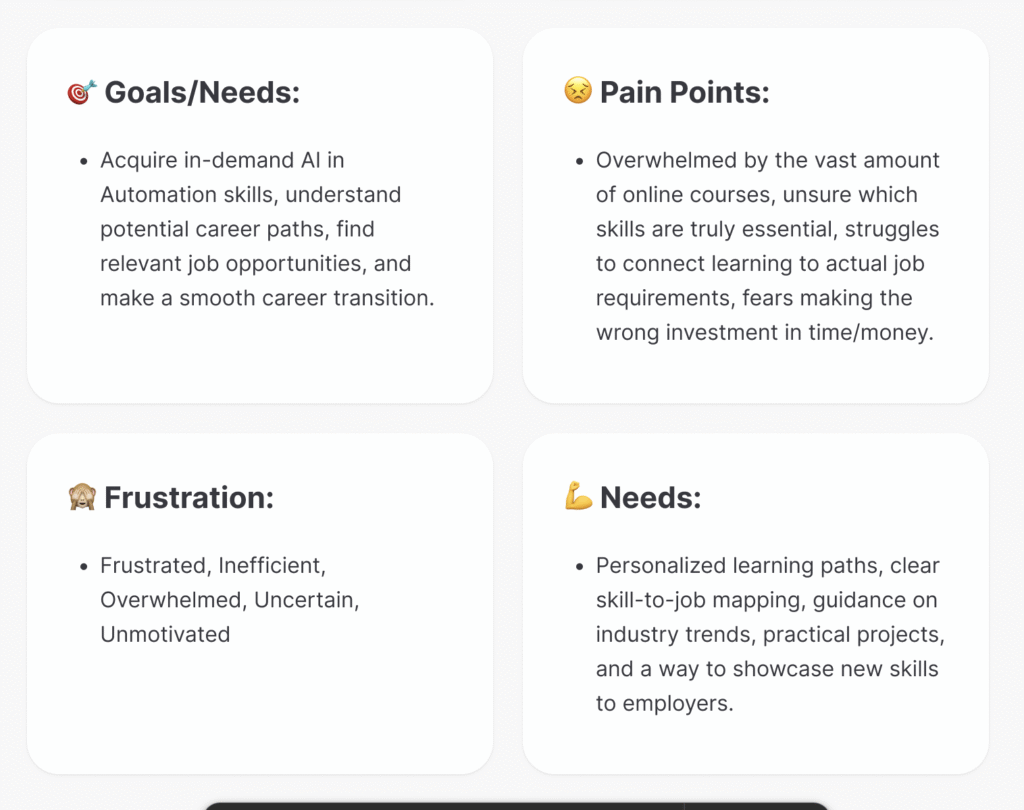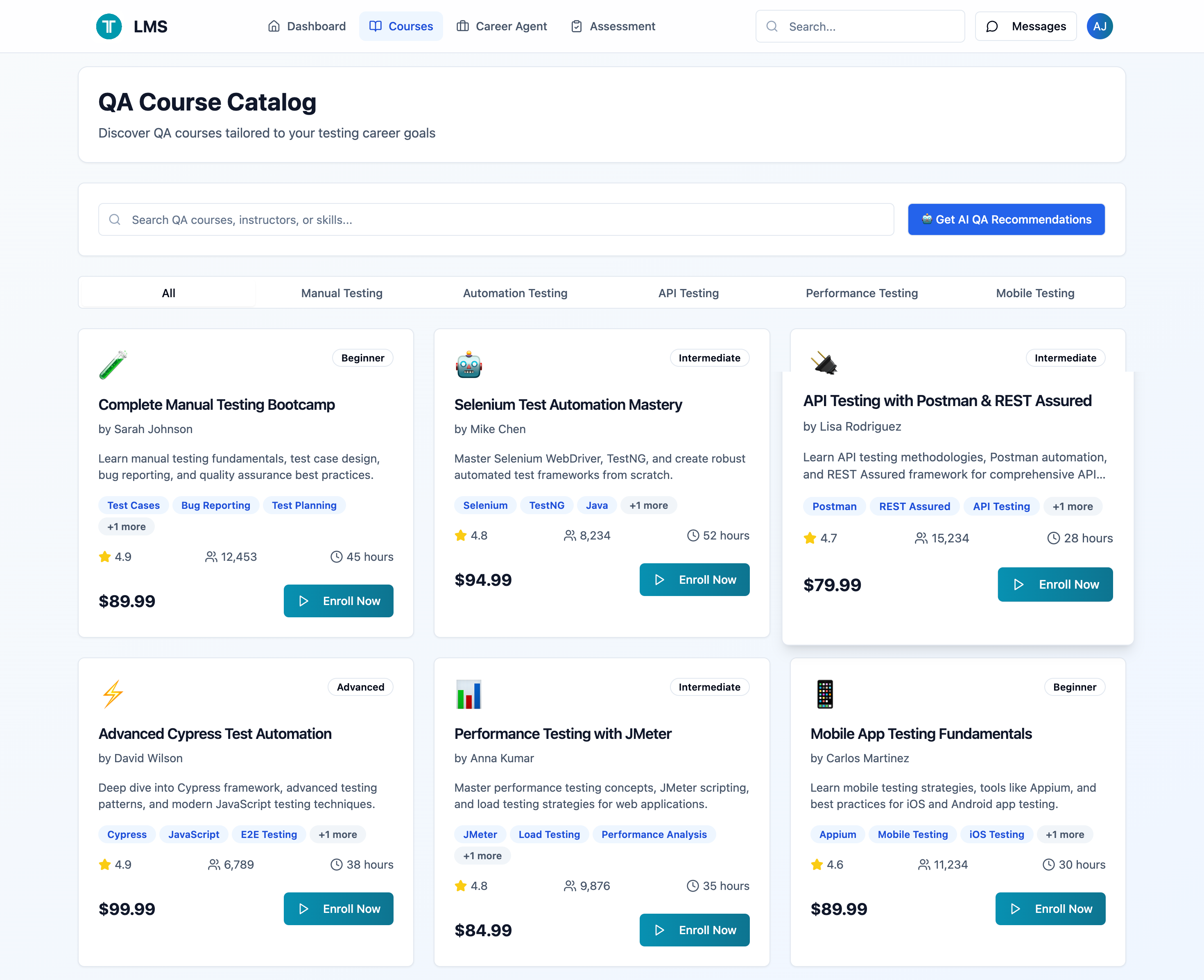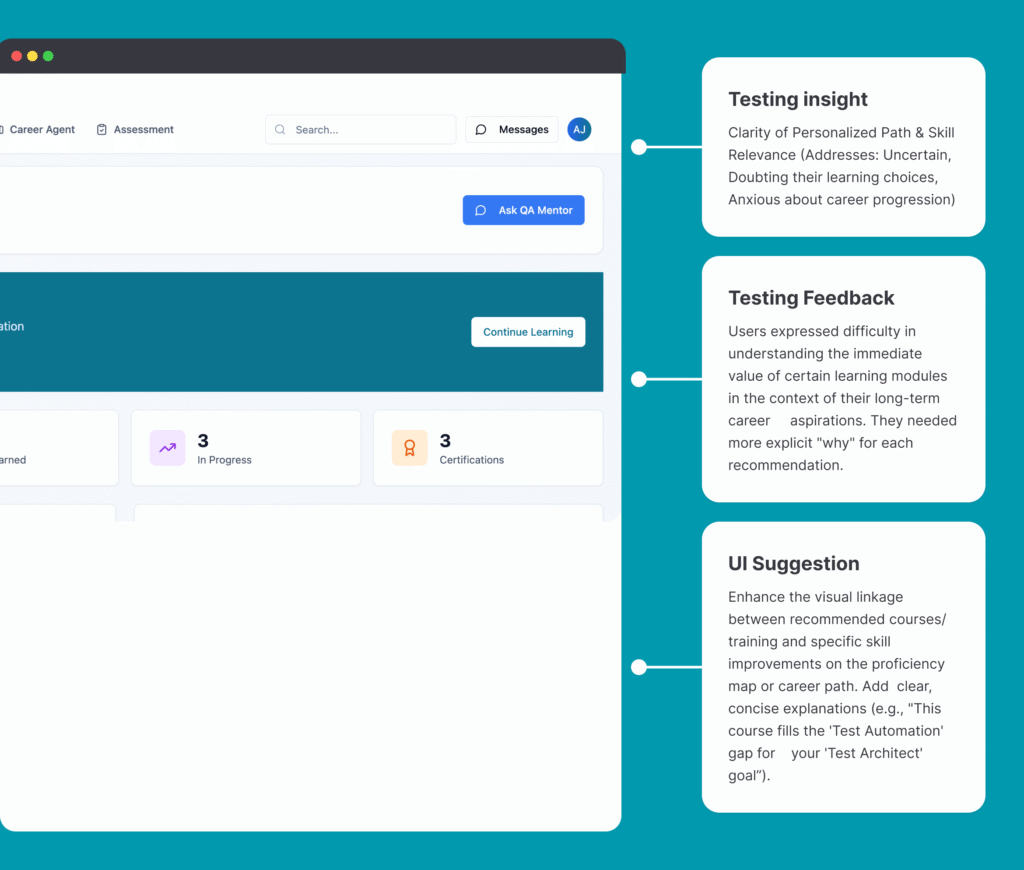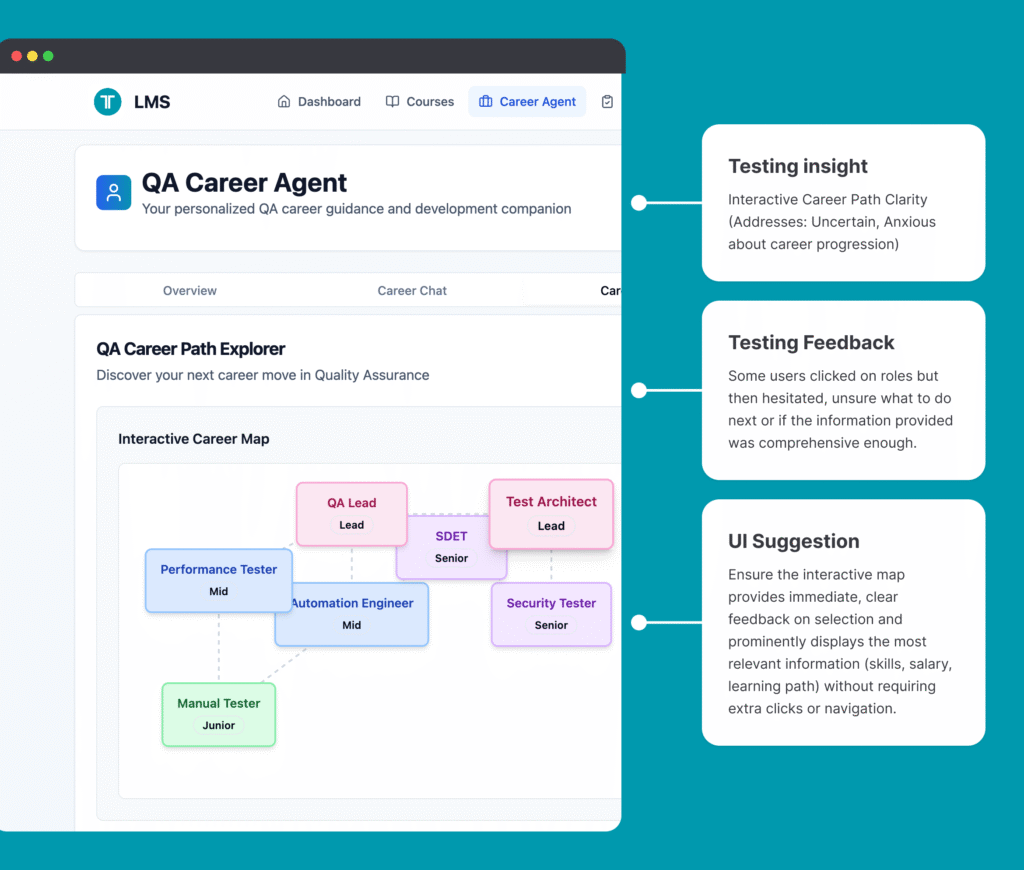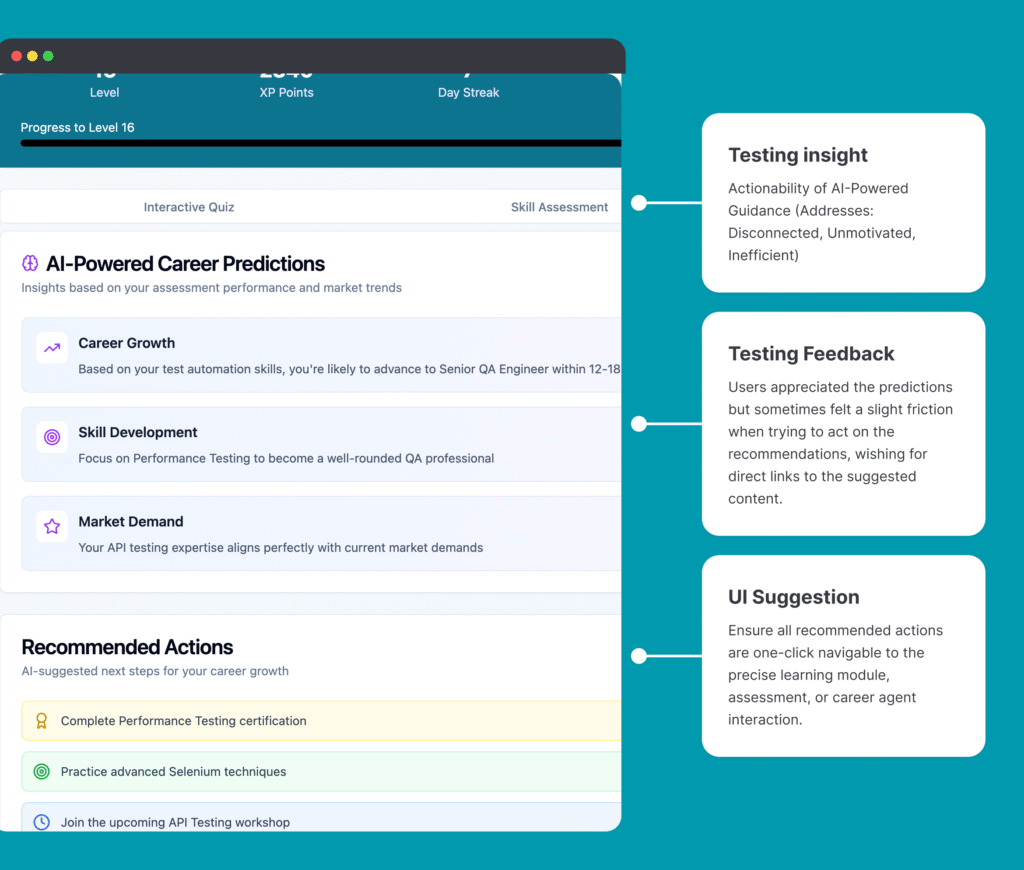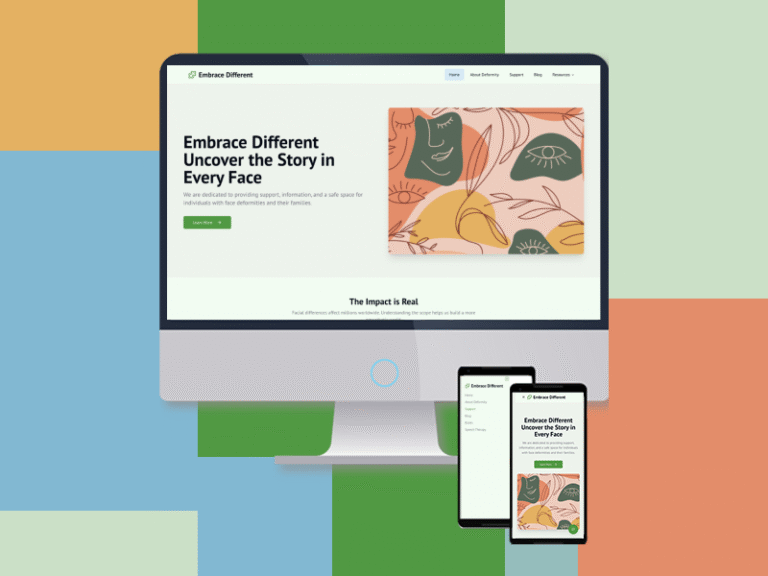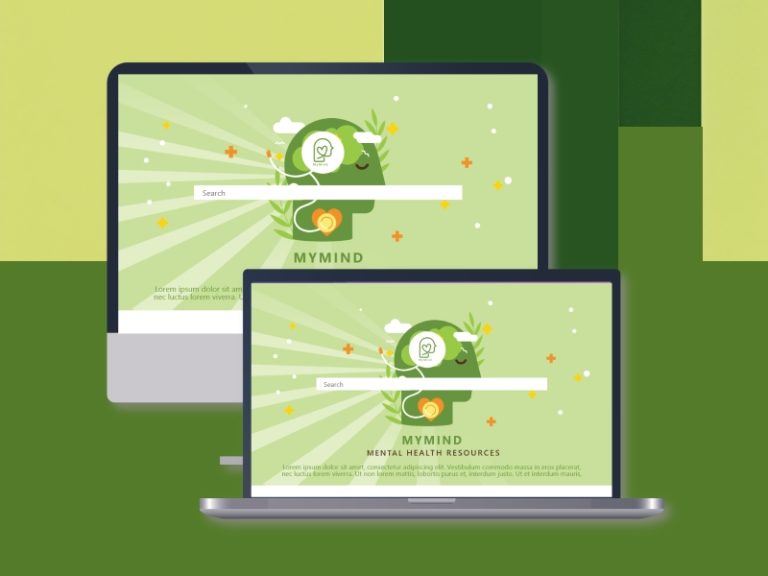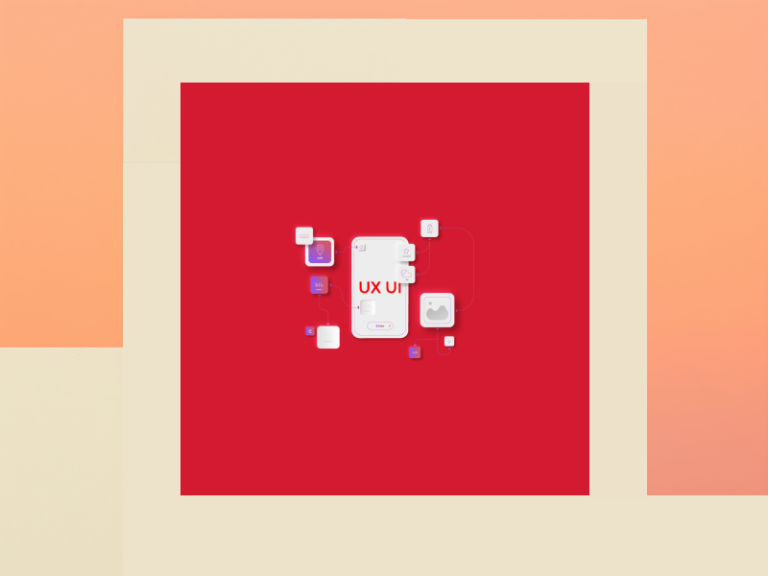An AI-powered LMS with Career Agent
Project Background
In today’s fast-changing world, traditional LMS platforms often fail to support future-ready skills and clear career paths. To address this, Test Tactix developed an AI-powered LMS with a built-in Career Agent, offering personalised learning and real-time career guidance. As the Digital Product and Learning Design Consultant, I led the design of this intelligent solution by integrating UI/UX, product strategy, and learning experience design. The result is a dynamic, user-focused system that moves beyond static courses to deliver truly adaptive, career-driven learning.
Problem and Solutions
Problem
The primary challenge addressed in this project was the fragmented and impersonal nature of existing learning and career development systems, which are particularly inadequate for professionals in fast-changing fields like Quality Assurance (QA).
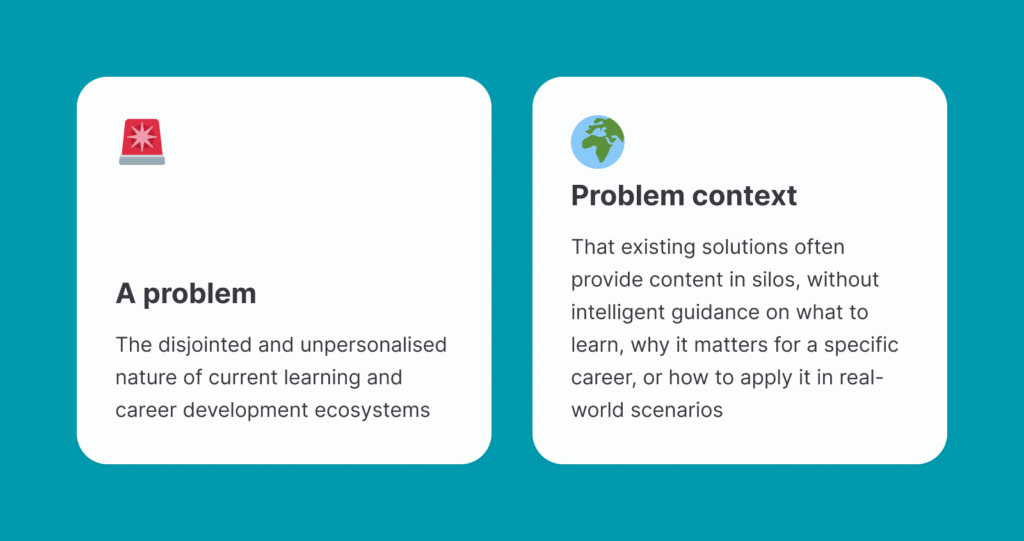
Target Audience
The primary audience includes individual learners, career changers, Corporate Companies and QA professionals seeking personalized learning experiences and clear career progression paths. They struggle with generic training programs and uncertainty about valuable skills.
Solutions
During the research phase (based on my working process), I used various techniques to generate potential solutions, including brainstorming sessions, concept sketching, wireframing, and analogy thinking. Through these methods, I developed core ideas such as:
- Personalized Learning Paths: Dynamic curricula tailored to individual goals, learning styles, and progress.
- Interactive Career Agent: A conversational AI interface providing guidance, answering questions, and recommending next steps.
- AI-driven Skill Gap Analysis: Automatically identifying a user’s current skills and suggesting relevant learning modules to close gaps for desired roles.
- Real-time Career Market Insights: Integrating job market data to show in-demand skills, salary trends, and potential career trajectories.
- Gamification, Skill Badges & Certifications: Verifiable credentials to showcase acquired competencies.
My Work Process: Design Thinking in Action
How I tackled this problem and successfully deployed practical solutions
My approach to this complex challenge was rooted deeply in the principles of Design Thinking, a human-centered methodology that emphasizes empathy, collaboration, and iterative development. This framework allowed me to systematically explore the problem space, generate innovative solutions, and validate our assumptions with real users, ensuring the final product was both desirable and effective.
The project unfolded across four distinct, yet interconnected, phases:
- Research: Understanding the core problems, user needs, and market landscape.
- Design: Translating insights into intuitive user experiences and compelling visual interfaces.
- Implementation: Building a Minimum Viable Product (MVP) to bring the core functionalities to life.
- Testing & Iteration: Validating the solution with users, gathering feedback, and refining the product.
This iterative cycle allowed us to continuously learn, adapt, and improve, ensuring the final solution was robust, user-centric, and aligned with the client’s strategic goals.
Research Phase
Over the past 3–4 months, Test Tactix aimed to uncover the root causes of key learning and career development challenges. Using both qualitative and quantitative methods, we explored learner behaviors, career goals, and organizational talent gaps. These insights shaped our problem definition and guided solution ideation, ensuring alignment with real user needs.
In this phase, I drew inspiration from platforms like Uxcel and Codecademy, which focus on teaching a single subject area with depth and clarity. Their structured, interactive learning approach helped me understand how subject-specific design can improve learner engagement and retention. This insight influenced my own approach to building focused, outcome-driven learning experiences.
Understanding User Needs, Pain Points, and Feedback
Our research involved:
- Surveys and Interviews: Reaching out to a diverse group of learners, career changers, HR professionals, and educators to understand their experiences with existing LMS platforms and career development tools.
- Competitor Analysis: Evaluating existing LMS platforms(Coursera) career guidance tools(Workable), and AI-driven learning solutions to identify strengths, weaknesses, and market gaps.
- Contextual Inquiry: Observing how users currently engage with learning content and make career decisions.
The feedback consistently highlighted:
- Lack of Personalization: Generic course recommendations that don’t align with individual goals or learning styles.
- Skill Gap Uncertainty: Difficulty in identifying which skills are most valuable for desired career paths.
- Disjointed Learning-to-Career Path: A clear separation between learning platforms and actual job market opportunities.
The findings revealed what are the pain points, feedbacks and user needs for a more integrated, intelligent, and personalized learning and career development experience.(This phase leveraged generative AI tools to some degree.)
Design Phase
The Design Phase transformed the validated concepts from research into tangible, user-friendly interfaces. my focus was on creating a seamless and intuitive experience that empowered learners and career changers with user centric design.
Information Architecture
I meticulously structured the content, ensuring seamless navigation between learning modules, career insights, and personal profiles. A hierarchical arrangement of courses, skills, and career paths was implemented through card sorting. This well-defined information architecture proved instrumental in crafting compelling UI designs for the MVP creation process on Uizard and Lovable.dev.
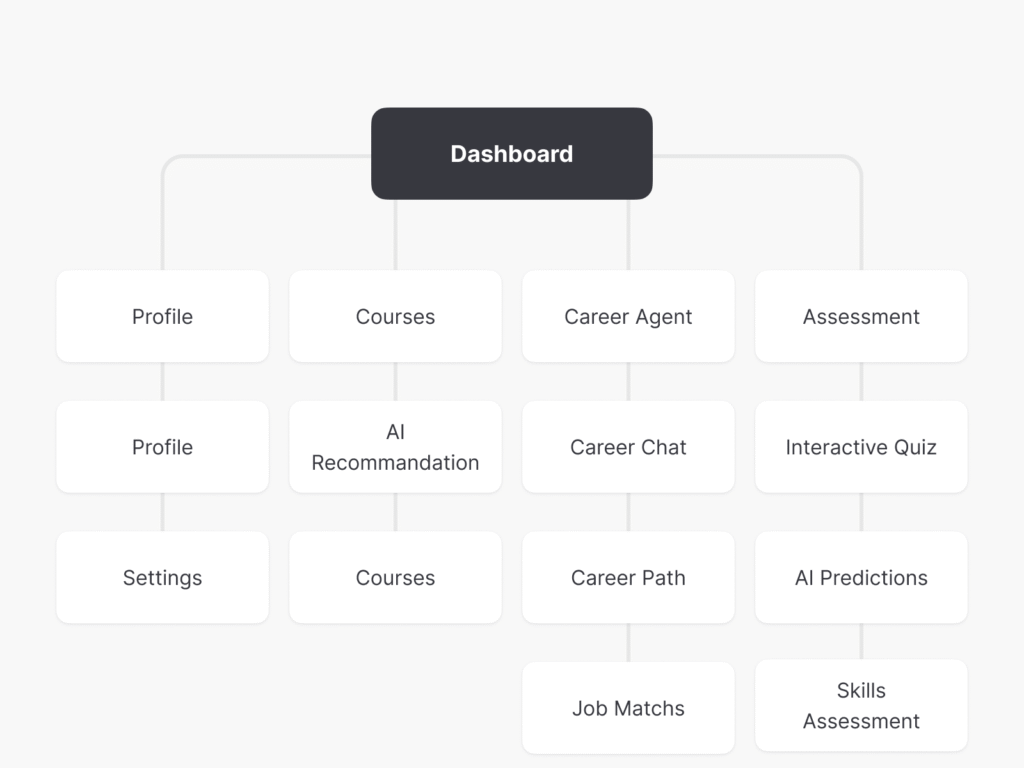
Sketch and Wireframe
I created wireframe through sketch in to wireframe in Uizard and this wireframes were created to quickly prototype layouts and test different arrangements of content and interactive elements. This allowed for rapid iteration based on internal feedback.
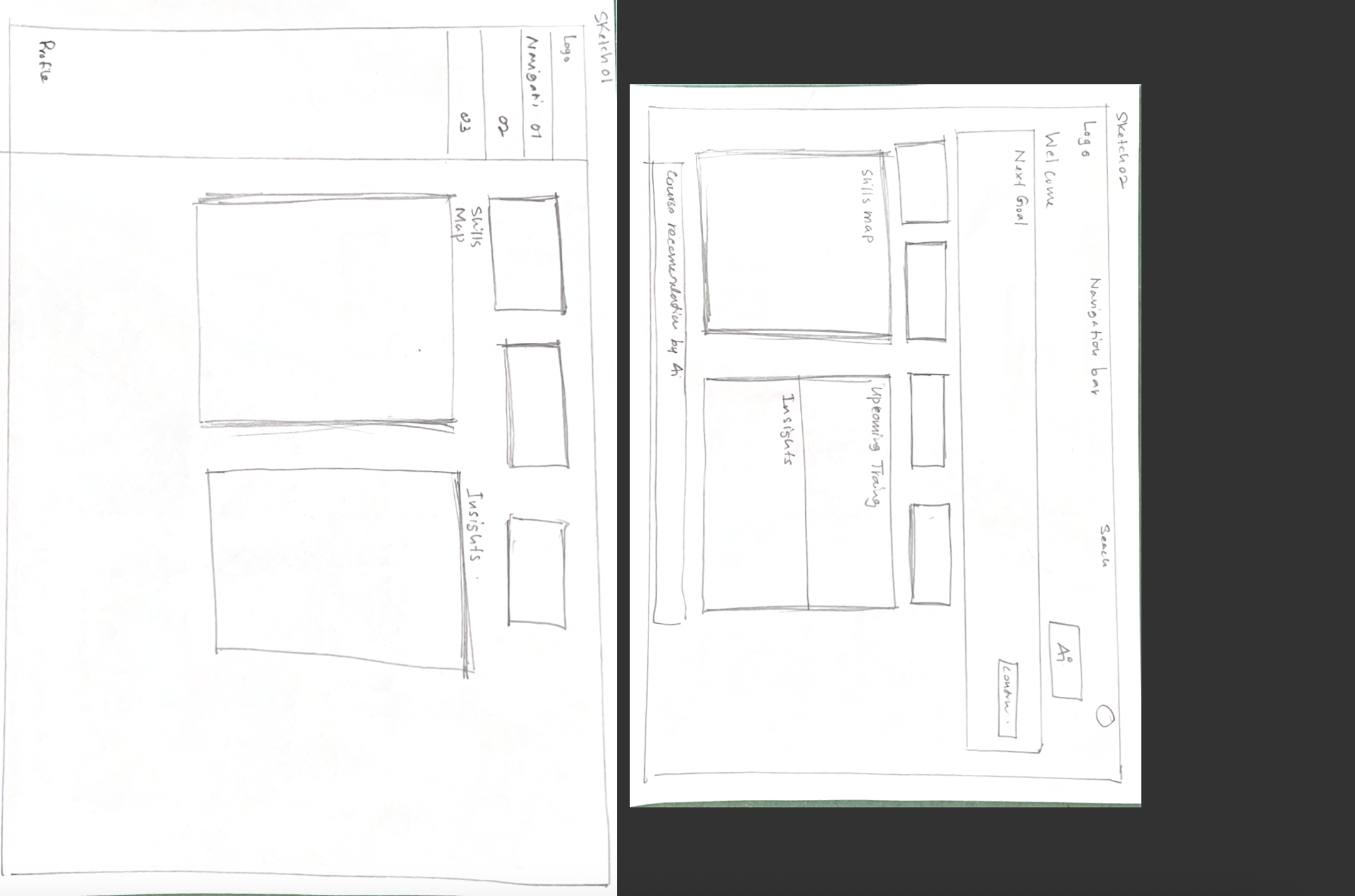
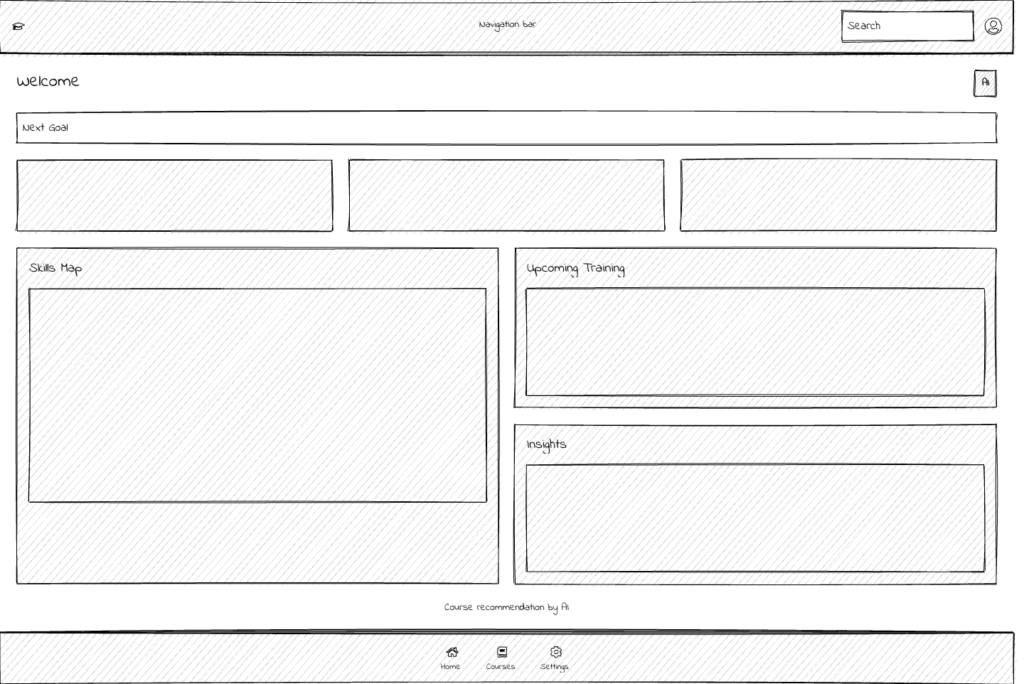
Prototypes
High-fidelity interactive prototypes were developed using prompt in lovable.dev and Uizard. These prototypes simulated the user experience, allowing users and early testers to click through the application and provide feedback on usability and functionality before significant development effort.

Design System
A comprehensive UI kit was developed, defining typography, color palettes ( Primary colour-#0099AE, Secondary Colour-#3b82f6,) iconography, and component styles.
I focused on clear prompts, natural language understanding, and empathetic responses to make the AI feel like a helpful guide rather than a rigid tool. Visual cues were designed to indicate when the AI was processing or generating recommendations. Well-built prompts provided extended assistance in building all visual designs across every page. Special attention was given to the design of the Career Agent’s conversational interface.(This phase leveraged generative AI tools comprehensively.)
Final Design
Dashboard
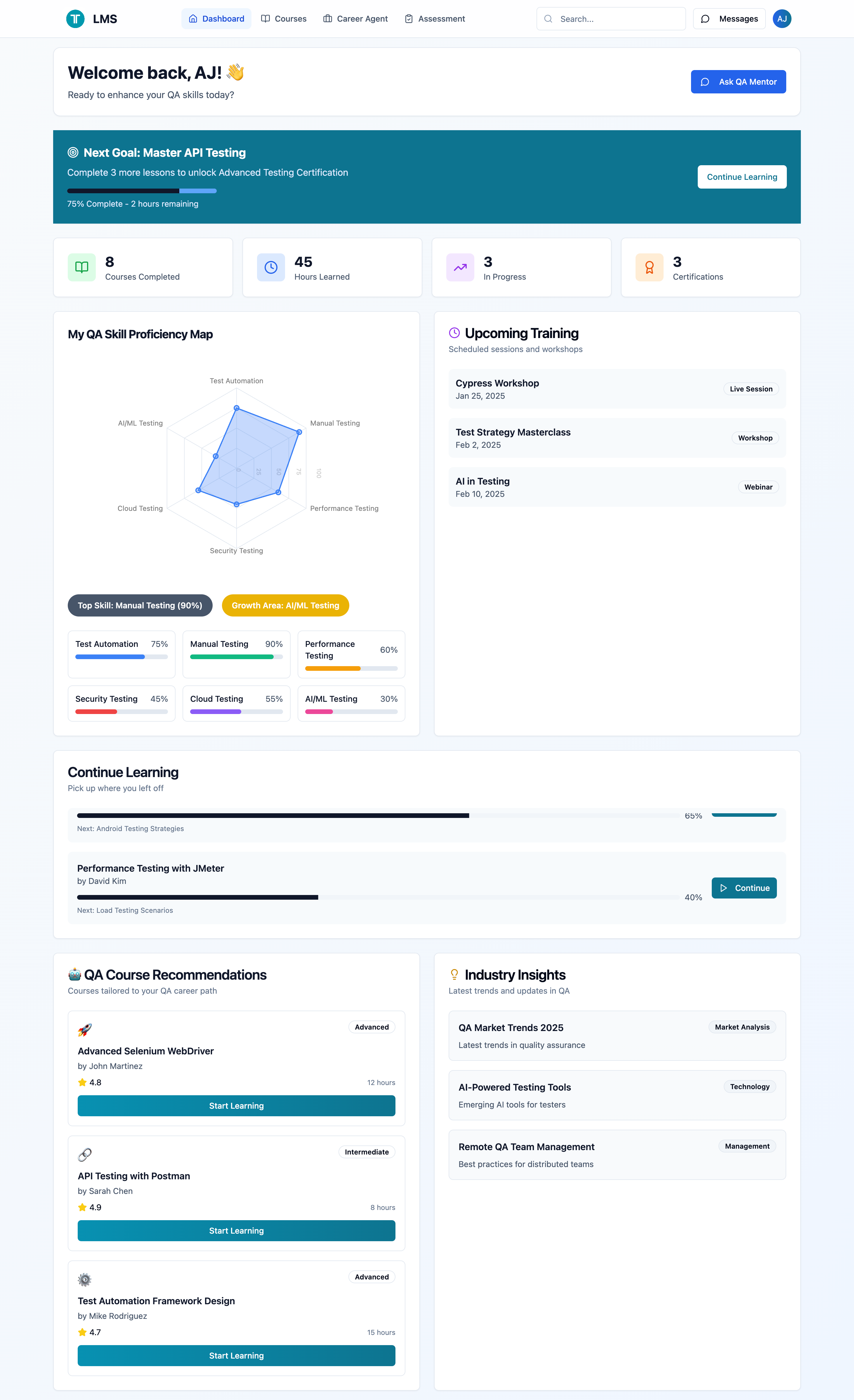
More Pages …
Implementation Phase (Build MVP)
The implementation phase focused on building a Minimum Viable Product (MVP) that encapsulated the core value proposition of the AI-powered LMS with Career Agent. The goal was to deliver a functional product quickly for early user testing and feedback, rather than a fully-featured system. (This phase leveraged generative AI tools comprehensively.)
Key Features
User Authentication & Profile Management: Secure login and user profiles to store learning history and career goals.
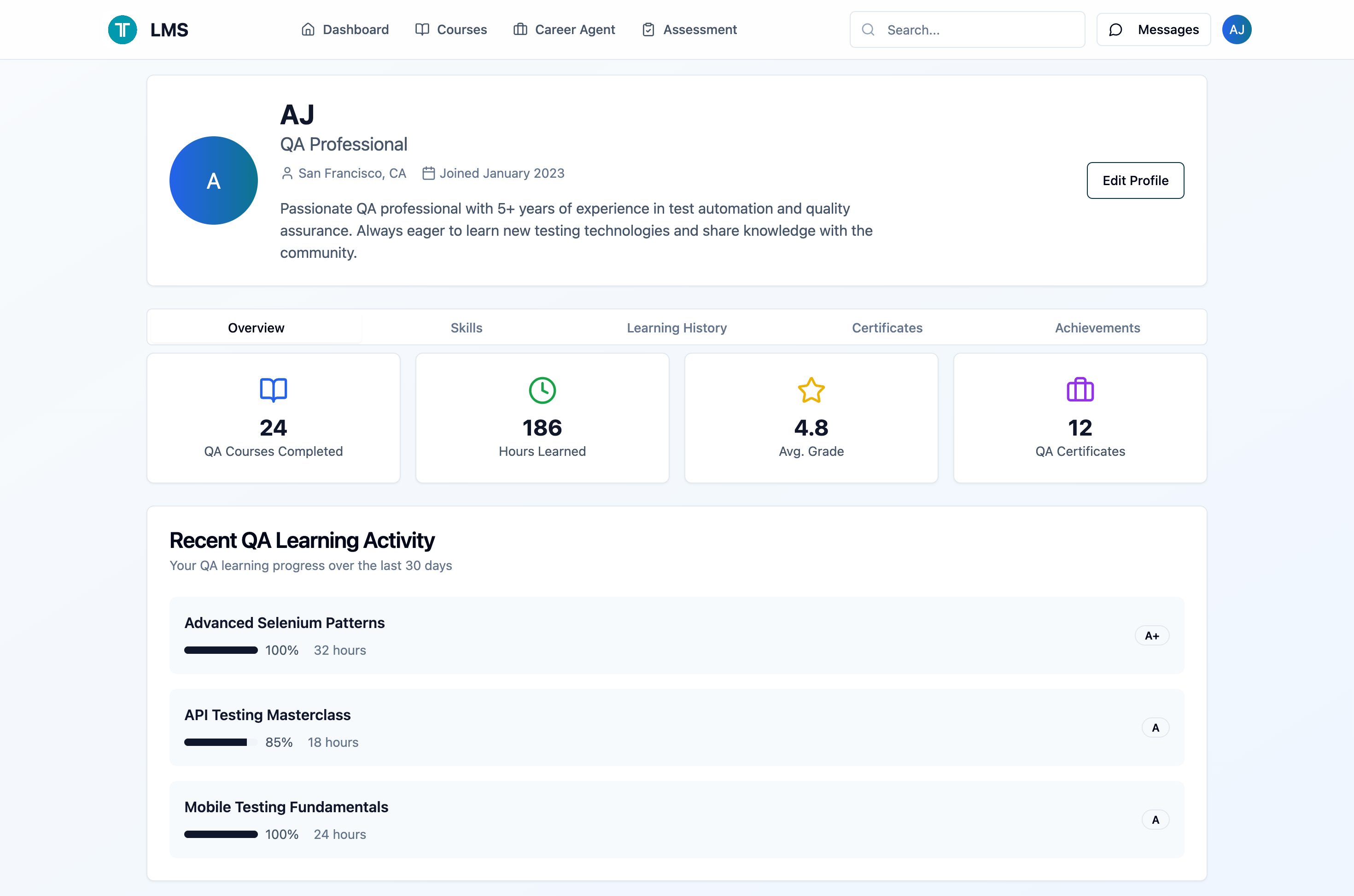
Progress Tracking: Simple dashboards to show completed modules and overall progress within a learning path.

Basic Career Agent Interface: A text-based interface where users could ask simple questions about career paths and receive general recommendations. This leveraged a pre-trained language model for initial responses.
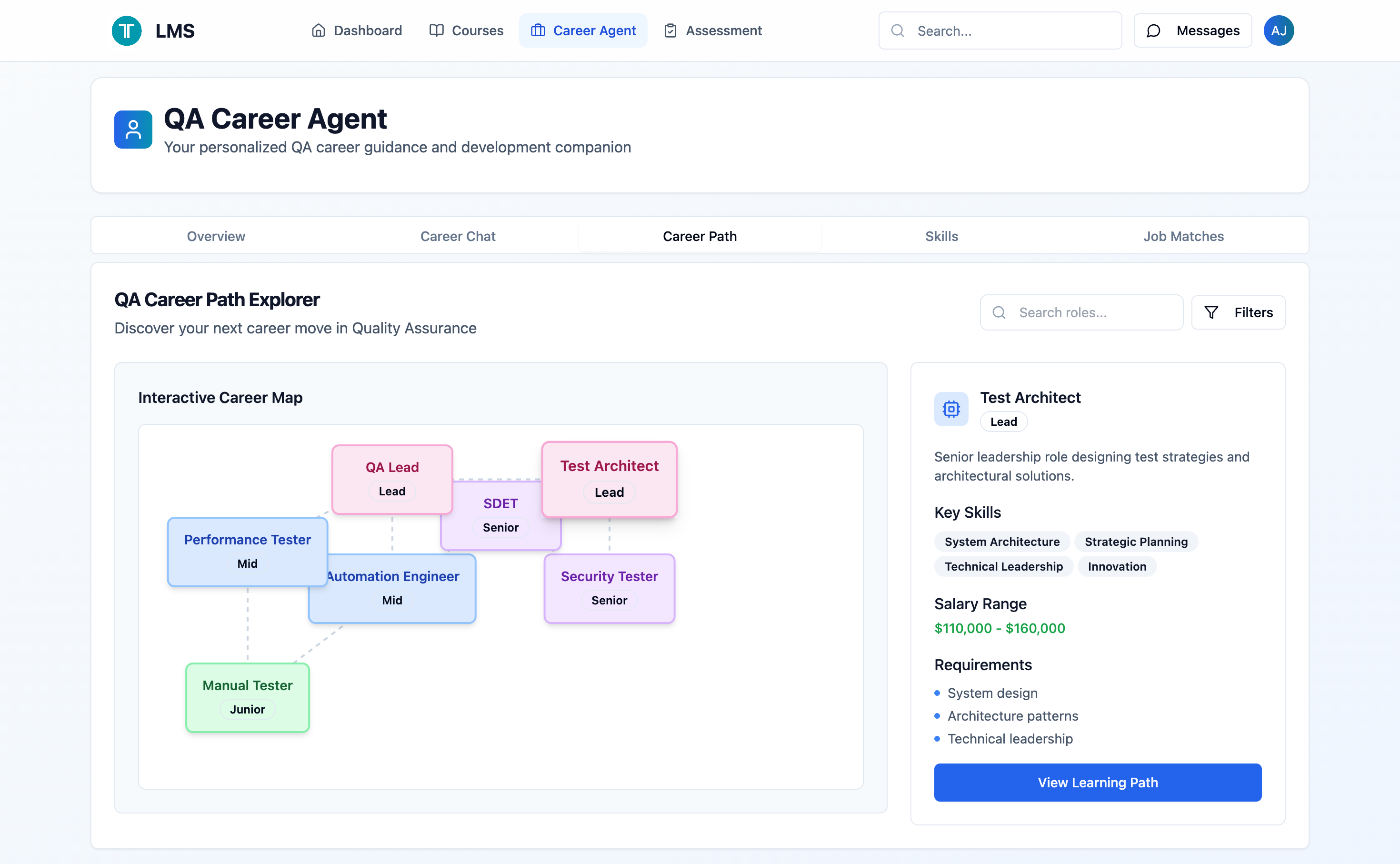
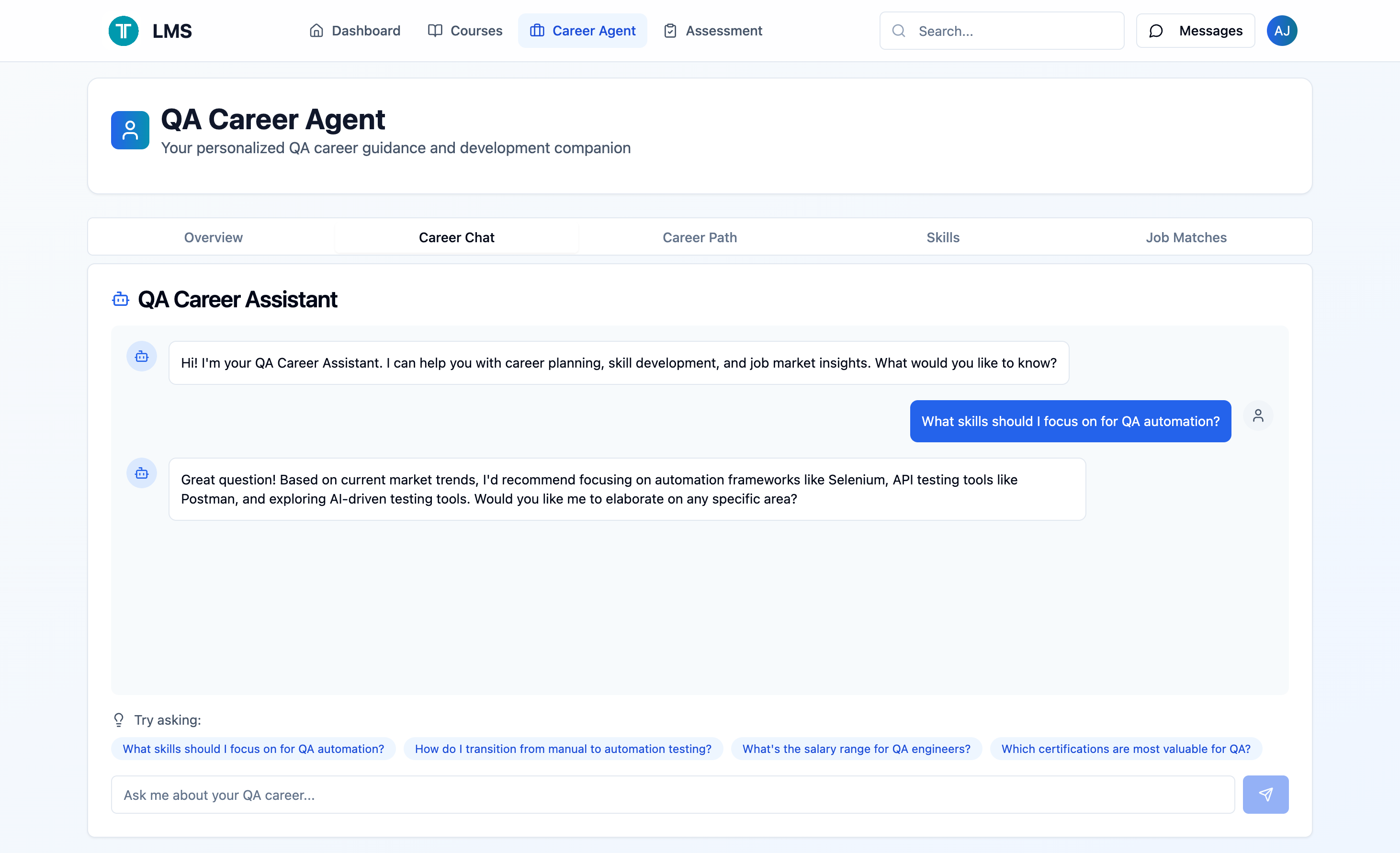
Initial Skill Assessment: A simplified assessment to capture baseline skills and career interests.
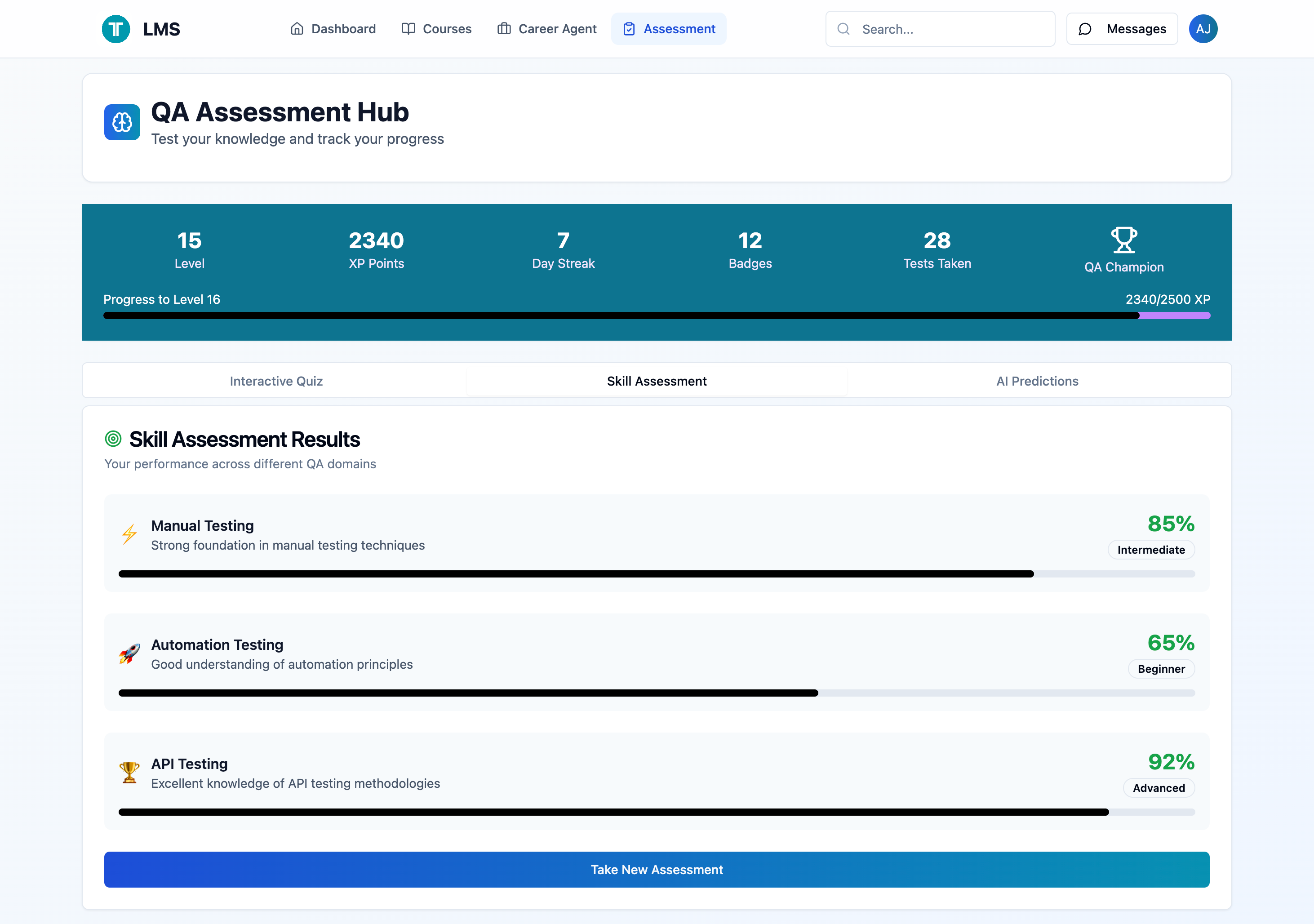
Personalized Learning Path Generation: An algorithm (initially rule-based with AI integration planned for later iterations) that suggests relevant courses and modules based on the skill assessment and desired career path.
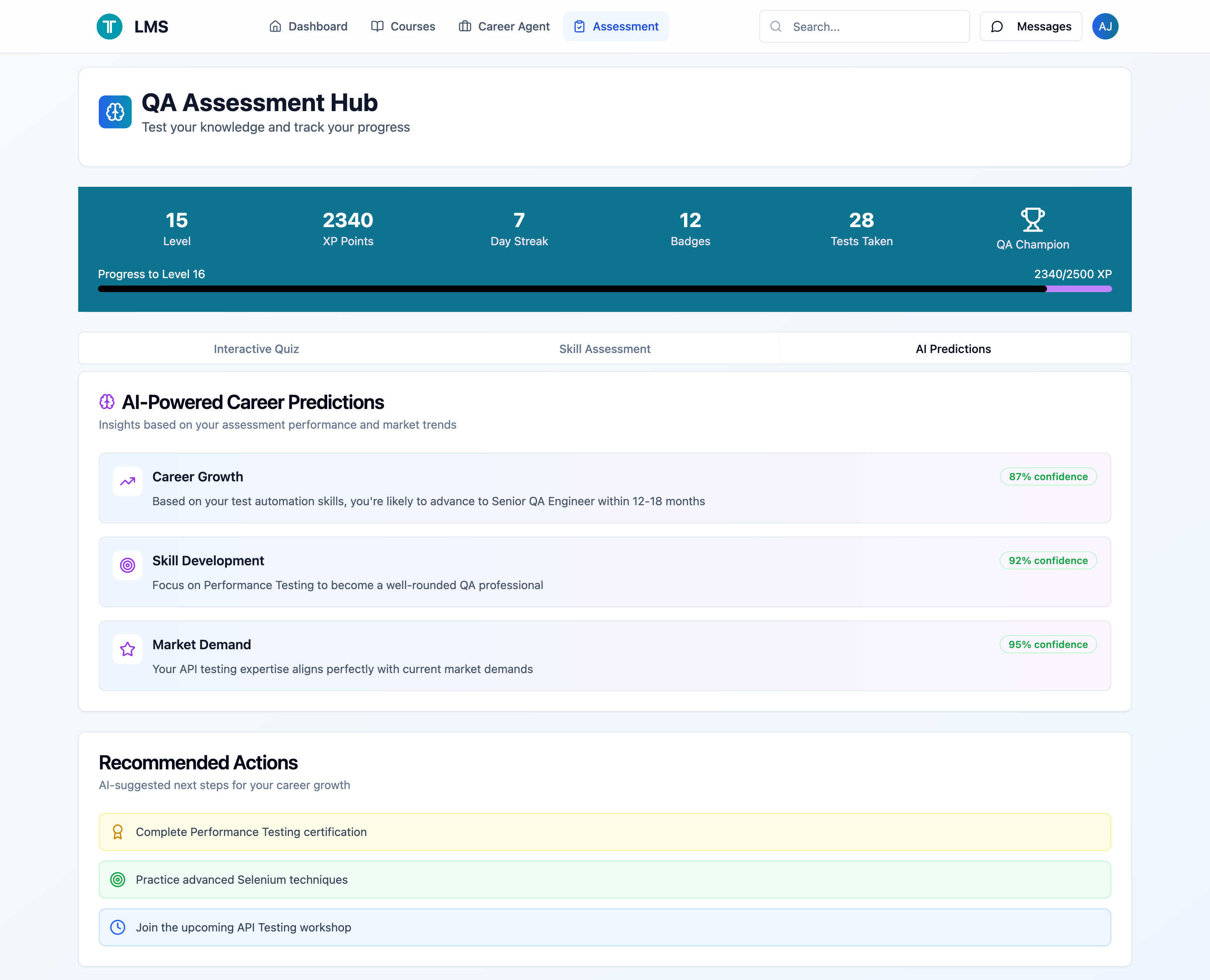
The MVP was developed with scalability in mind, using a modular architecture to allow for easy integration of more advanced AI models, richer content types, and additional features in future iterations. Visit AI Powered TT LMS
Testing Insights Phase
The testing phase was pivotal for validating the design assumptions and pinpointing areas for enhancement prior to a broader release. I conducted usability testing with a diverse cohort of target users, encompassing those conforming to the personas and my colleagues who are already proficient in QA automation.
Testing Methodology and Key Testing Insights
Tesing Methodology
- Task-Based Scenarios: Participants were given specific tasks to complete within the MVP (e.g., “Find a course to learn AI in automation,” “Ask the career agent about becoming a Automation Engineer,” “Track your progress in a learning path”).
- Think-Aloud Protocol: Users were encouraged to vocalize their thoughts, frustrations, and expectations as they navigated the platform.
- Observation: Researchers observed user interactions, noting pain points, confusion, and areas of delight.
Key Testing Insights
These insights directly informed subsequent design iterations, ensuring the product evolved based on real user feedback, leading to a more intuitive and effective learning experience.
Accessibility Enhancements
To ensure the product is fully inclusive and WCAG-aligned, I implemented a comprehensive set of accessibility improvements across the interface. These updates include
- Added skip links for keyboard users to quickly jump to main content.
- Applied ARIA labels, roles, and attributes across navigation, buttons, forms, and regions.
- Refactored structure using semantic HTML (
<header>,<main>,<nav>,<section>,<article>). - Designed enhanced focus states with clear and visible focus rings.
- Improved screen reader support using
aria-label,aria-current,aria-live, andsr-only. - Added reduced motion support for users who prefer minimal animation.
- Implemented high-contrast mode for better visibility.
- Ensured a logical heading hierarchy (h1 → h2 → h3) for readability and assistive tech.
- Improved form accessibility with labels, hints, and proper search roles.
- Updated progress indicators using correct ARIA attributes.
- Marked decorative icons with
aria-hidden="true"to avoid screen reader clutter.
These improvements make the product significantly more usable for all users, including those with visual, cognitive, and motor disabilities.
Conclusion
Future of the Project
The MVP provides a robust foundation for the AI-powered LMS and Career Agent. Future enhancements will focus on deeper personalization, expanded career guidance, and fostering a stronger community.
As a designer, I plan to integrate OpenAI’s capabilities to push the boundaries of AI in design and product functionality.
This advanced AI integration will further enhance content recommendations, career agent capabilities, and interactive learning, while also introducing enterprise features like team skill gap analysis, customizable learning paths, and HRIS integration.
What I Gained
- AI-Driven UX Design: Gained invaluable experience designing intuitive interfaces for AI-powered features, focusing on managing user expectations and providing clear feedback.
- Iterative Development Mastery: Reinforced the critical importance of continuous research, prototyping, and testing for successful product development.
- Strategic Product Thinking: Developed a stronger ability to connect user needs and technological capabilities with business goals and market opportunities.
- Complex Problem-Solving: Successfully integrated diverse functionalities (LMS, career guidance, AI) into a cohesive user experience.
- Leveraging Generative AI: Utilized generative AI tools (like Lovable.dev) to streamline the design phase, demonstrating AI’s role as an invaluable assistant in enhancing designer productivity and delivering exceptional results.
- WCAG-compliant Interface build
What Client Gained
- Enhanced Engagement & Retention: Early MVP testing showed a 32% increase in user engagement with personalized learning paths and a 28% higher completion rate from 12% for recommended courses, reflecting stronger user motivation.
- Reduced Skill Gap & Improved Workforce Readiness: The platform’s targeted learning and career guidance will significantly reduce the time to acquire in-demand skills, boosting overall workforce readiness.
- Competitive Differentiation: AI-powered personalization and the career agent offer a unique selling proposition, attracting learners seeking tailored development.
- Data-Driven Insights: The platform’s architecture facilitates collecting rich data on learning behaviors and career trends, providing valuable insights for future strategy.
- Future-Proofed & Scalable: The MVP offers a flexible foundation for integrating advanced AI and expanding into new markets.
- WCAG-compliant
The project “Redefining Learning & Careers — An AI-powered LMS with Career Agent” was a meaningful journey in human-centered design and innovation. Using the Design Thinking methodology, I turned a complex challenge into a practical, user-validated solution.
This initiative proved that integrating an AI-powered LMS with a career agent is not only viable but highly impactful, making learning more relevant, career paths more accessible, and personal growth more achievable. By focusing on real user needs, embracing iteration, and leveraging intelligent technology, the project showcased the true power of AI and design thinking in transforming modern education.

